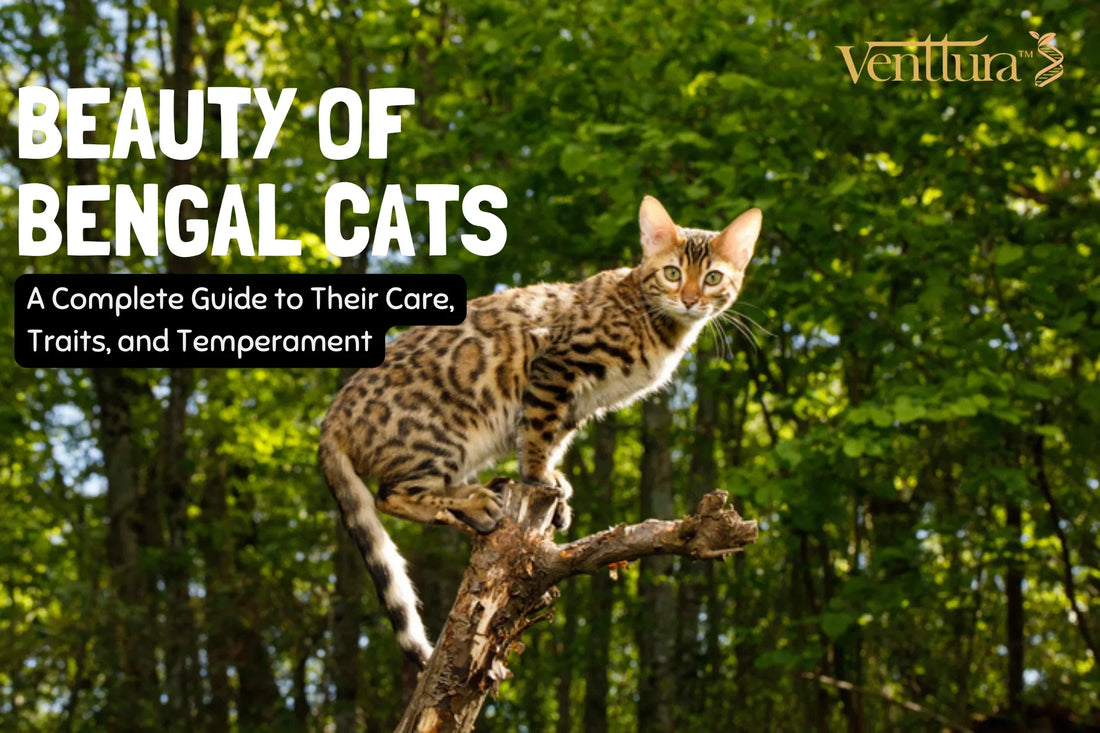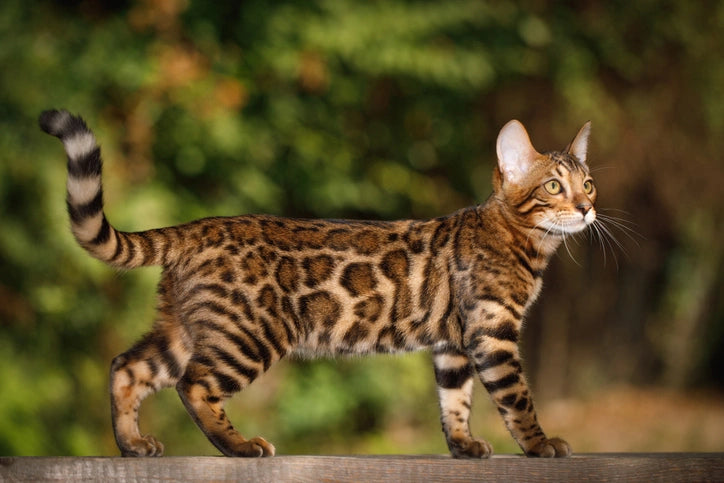
Unleashing the Beauty of Bengal Cats: A Complete Guide to Their Care, Traits, and Temperament
Beauty of Bengal Cats: A Complete Guide to Their Care, Traits, and Temperament

Bengal Cats Introduction
Bengal cats are more than just cats- they're a hypnotic blend of the wild and the playful. These spotted felines, with their majestic coats and piercing emerald eyes capture the hearts and homes of everyone they meet. But there is more to Bengal cats than meets the eye. This guide will provide insight into what makes Bengals special, their charming personality, and how to care for your Bengals to ensure they are healthy and happy. Whether you’re a new parent or planning to welcome a new fur baby into your home, it’s important for you to know what your cat needs and how it will act to ensure that you both form a wonderful, loving relationship. Whether you love their playful energy or cuddly affection, Bengal cats are nothing if not sweet kittens to have around. Join us as we delve into the magical world of Bengal cats and learn from the best of the best secrets of raising and living with these amazing companions.
Unique Traits and Characteristics of Bengal Cats

Bengals are popular for their striking appearance - passed on from their wild ancestors - the Asian leopard cats. Their luxurious, leopard-like coats are covered in rosettes, spots, or marbling, giving them a jungle vibe with a domesticated soul. Bengal cats are medium-sized to large cats that are both muscular and agile. They have a smooth coat that is soft to the touch and shines in the sunlight. Most Bengals, unlike many other cats, love water and may follow you into the shower and even jump into the sink full of water!
Key traits:
High energy and curiosity
Intelligence and rapid learnability
Vocally and expressively outspoken characters
Allergenic/ Hypoallergenic (shedding and dander)
How to Understand the Character of Bengal Cats

Bengal cats are very social; they bond strongly with their human family members. They love company, subject to play or mental stimulation. When left to their own devices or are bored, they may become anxious or destructive. Bengal cats are often described as dog-like; they may follow you from room to room, retrieve toys, or respond to commands.
Their temperament includes:
High need for engagement and stimulation
Strong territorial instincts
Playful and mischievous nature
Generally get along well with children and other pets (if socialized early)
Essential Care Requirements for Bengal Cats
Bengals do not need just basic feeding and litter box care. They thrive in a stimulating, enriched environment with plenty of vertical space, toys, and interactive play. Puzzle toys, treat dispensers and climbing trees will keep your Bengal engaged.
Daily needs:
30–60 minutes of active play
Scratching posts and climbing spaces
Clean the litter box daily (Bengals are clean animals)
Proper grooming and veterinary care
Nutrition and Diet Tips for Healthy Bengal Cats

Bengals have high energy demands and require a high-protein diet. Opt for high-quality cat food with real meat listed as the first ingredient, or speak to your vet about a balanced home cooked diet boosted with high quality supplements.
Tips:
High-quality kibble wet food or home-cooked food
Limited grains
Clean, fresh water at all times
Divide meals into 2–3 portions daily
Recommended Supplement from Venttura

To support your Bengal's overall vitality, consider amino+ Cat. This amino acid, antioxidants, and multivitamin formula supports growth, strength, protein synthesis, and antioxidant protection—perfect for the high energy needs of Bengals.
Grooming and Maintenance for Bengal Cats
Bengal cats are also low-maintenance groomers, despite their striking appearance. They have a short, fine coat that doesn’t tend to mat and sheds less. Brushing weekly removes loose hair, reduces hairballs, keeps skin supple, and promotes bonding between you and your cat
Grooming checklist:
Weekly brushing
Nail trimming every 2–3 weeks
Ear cleaning monthly
Dental care—brushing
Best Ways to Socialize and Train a Bengal Cat
Bengals are intelligent cats that pick up on their parent's signals and can be trained through clicker training, positive reinforcement techniques, or voice commands combined with treats. Socialization out of the gate is key for avoiding bad behaviors.
Training ideas:
Litter box training
Teaching “sit,” “high five,” or “fetch”
Using a leash and harness for safe outdoor walks
They enjoy climbing, hiding, and ambush games, so you won’t regret investing in interactive toys and tunnels.
Bengal Cats Common Health Problems and How to Prevent Them
While Bengals are generally healthy, they may be prone to certain conditions:
Hypertrophic Cardiomyopathy (HCM)
Progressive Retinal Atrophy (PRA)
Patellar Luxation
Feline Infectious Peritonitis (FIP)
Regular vet checkups, genetic screening, and preventive care are essential. Good nutrition and supplements like Venttura immuno+ Cat (colostrum & lysine-based formula) can help strengthen their immune system, reduce anxiety, and offer antioxidant protection.
Setting Up an Environment Suitable for a Bengal Cat
Bengals need a richer setting at home to stimulate their minds and bodies active. Consider vertical space, puzzle feeders, and interactive play.
Environment essentials:
Cat trees and window perches
Rotating toys to prevent boredom
Safe outdoor enclosures (catios)
Hiding spots and cozy nap zones
Adding natural supplements like Venttura omega+ Cat helps maintain healthy skin and coat, supports joint and digestive health, and reduces inflammation—all of which are important for such active and sensitive cats.
Also consider livo+ Cat if your Bengal shows signs of poor appetite, digestion issues, or urinary concerns. It supports liver health, detoxification, and urinary tract protection.
Frequently Asked Questions About Bengal Cats
1. What exactly is a Bengal cat?
Answer: A Bengal cat is a hybrid breed created by crossing a domestic cat with the wild Asian leopard cat. They were first recognized by TICA (The International Cat Association) in 1986, and are known for their wild, leopard-like appearance combined with a friendly, domestic temperament
2. How much do Bengal cats cost?
Answer: The price varies depending on pedigree and breeder. Expect to pay roughly ₹65,000 to ₹2,00,000 for a pet-quality Bengal, and even more for high-demand show-quality lines.
3. Do Bengal cats shed or are they hypoallergenic?
Answer: Bengals are low-shedding compared to many other breeds, making them somewhat easier for allergy sufferers. They’re often referred to as hypoallergenic, though no cat is completely free of allergens.
4. Can Bengal cats be trained to walk on a leash?
Answer: Yes! Bengals are intelligent and active, and many can be leash-trained using harness and clicker training. This gives them safe outdoor stimulation and strengthens their bond with you.
5. Do Bengal cats like water?
Answer: Unlike most breeds, Bengals often enjoy water—they may follow you into the shower, play with faucets, and even swim, thanks to their wild ancestry.
Summing Up: In Acceptance of the Bengal Cat Experience
It is really fun to live with a Bengal cat. They are as ‘wild’ as they are loving and affectionate. By getting to know their unique personalities and providing for their physical and emotional needs, you can create a lifelong friendship that is filled with happiness and companionship for years to come.
With just the right diet, enrichment, and added support from supplements like omega+ Cat, immuno+ Cat, amino+ Cat, and livo+ Cat, your Bengal cat can live their healthiest life. Are you ready to bring the stunning beauty of Bengal cats to your home? Shop at venttura.com and browse supplements made with love for your feline family!
